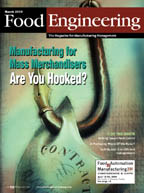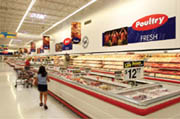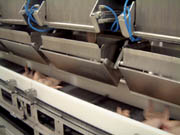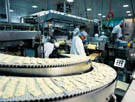

In a slow-growth industry, food processors can scarcely ignore mass merchandisers as their best bet to meet higher sales targets. Supermarkets, the historic volume leaders, are experiencing steady sales erosion, and forecasters predict their 53 percent share of the food market will slip below 40 percent by 2010. Club stores led the assault on grocery-store volume in the 1990s, and they are being joined by mass merchandisers' supercenter formats in taking greater share from conventional grocers.
Muffled cheers over the demise of traditional grocers can be heard in many manufacturing circles. Slotting fees, co-op ad budgets, display fees and "the 15 line items beyond the negotiated price" are the real profit centers for supermarkets, points out retail consultant Neil Z. Stern, a partner in Chicago-based McMillan Doolittle LLC. "With a club store, the focus is on how well the item sells. If you can outperform the product currently on the shelf, you can have the space."
The down side is that channel power is being concentrated in a relative handful of retail accounts. In 2002, Kraft Foods generated more than $3.6 billion of its revenues from Wal-Mart alone-12.2 percent of its net. Asks Stern: "Does that make you a little nervous? Yes, but where else are you getting 10 percent growth?"

The same holds for regional chains such as BJ's Wholesale Club and Meijer, where packaged food generates store traffic. These stores pose a growth opportunity for food and beverage processors, though adjustments in conventional manufacturing practices must be made.

Let's see the books
While buyers for club stores and supercenters are less interested in negotiating "the buy side of the equation," as Stern puts it, they are keenly interested in knowing what a supplier's actual costs are. "Large manufacturers are being pressured to disclose an account profitability statement," according to Jim Hertel of Barrington, Ill.-based Willard Bishop Consulting. "They don't want to say what their profitability and cost of delivering product are, but they are under tremendous pressure to become more efficient and lower their cost of goods sold."Getting a better fix on manufacturing costs was one of the objectives in the deployment of an automated production management system at Barber Foods. Steve Barber, president of the $200 million family-owned firm, declined to discuss how much information-sharing is done with major retail accounts, but better tracking of finished goods, scrap rates and labor costs was a major benefit of the supply-chain management system the company installed in 2002.
Founded in 1955, the Portland, Me., company boasts it was the first northeastern processor to offer its customers cut-up chicken, later adding value-added products such as cordon bleu and chicken Kiev. The company supplies traditional grocers and club stores, including Sam's, Costco and BJ's. Packaging and portion sizes differ, with 6 oz. portions targeted for conventional retailers and a 7 oz. version tailored for the clubs.
Customer diversity means product diversity, and frequent changeovers are the rule at Barber. Labor accounts for half the company's processing costs, and groups of workers are deployed to different areas throughout their shifts. Line supervisors used to enter labor data into Excel spreadsheets; today, touchscreens on the plant floor capture production time and labor information for specific orders, resulting in immediate information on the cost of goods sold.
Even when account profitability isn't an issue, the sheer size of mass merchants' purchase orders creates scheduling issues. "Everybody in food and beverage is using Excel to schedule," suggests Jonathan Knight, CEO of JRG Software, San Mateo, Calif. "That was okay when the schedule didn't change much, but with mass merchandisers, it changes daily." JRG is rolling out Factory Scheduler, a module that combines cost accounting and production scheduling capabilities to optimize production, particularly at food plants juggling the different demands of conventional retailers and "power retailers" such as Wal-Mart who demand on-time deliveries.
San Leandro, Calif.-based Ghirardelli Chocolate is integrating JRG's package with a JD Edwards ERP system. Ghirardelli builds to stock, and the Edwards system does the heavy lifting for long-range schedules, explains Manuel Wildberger, vice president of operations. Visibility to daily production costs is another matter, and that is where he sees Factory Scheduler contributing to profitability.
"The club-store work orders are huge, and they can require production runs exceeding three weeks," Wildberger says. An ERP program can schedule those runs, but "optimizing the daily work load in terms of labor utilization" is another matter. "I have high hopes that (the JRG) system is going to help a lot with labor utilization."
Daily schedules are more fluid at Monterey Pasta Co., which implemented Factory Scheduler last summer. The Salinas, Calif., maker of fresh pasta produces to order. Club stores account for more than half of Monterey Pasta's sales, and the orders arrive and ship like clockwork. Unfortunately, they are subject to frequent revisions, and the changes can be significant.
"An order might come in Tuesday for Friday pickup, and then Thursday we get a call to increase it by 100 cases," according to Dan Brown, vice president of operations. "When we were manual, it was pretty hard to tell if we could deliver an extra 100 cases." The manual system was a bookkeeper and an Excel spreadsheet. Order changes often were not communicated to the bookkeeper, causing her spreadsheet to show more finished goods on hand than actually existed. Now, the scheduling program maintains the inventory database and calculates whether or not change-orders can be accommodated in the time available. "It simplifies what we do in terms of scheduling," says Brown, "and it sorts the accounts out so that we can have longer runs and fewer changeovers."

Supply chain mastery
Wal-Mart also has taken the lead in radio frequency identification (RFID) for case- and pallet-shipments from suppliers to its distribution centers (see "Brave New RFID World," Food Engineering, January 2004), and it has mandated that suppliers register their products with UCCNet, an electronic data interchange (EDI) synchronization service under the auspices of the Uniform Code Council. Kroger, Safeway and other supermarket chains also are participating in UCCNet, but Wal-Mart is driving the global registry."Club stores tend to set the standards on EDI, RFID and other supply-chain initiatives," observes McMillan Doolittle's Stern. "If there's to be a logistics standard, it's going to be set by the mass merchandisers." Those standards have attendant costs: a study by consultants A.T. Kearney suggests manufacturers will spend $400,000 per facility to become RFID compliant, plus another $6,600 annually per $1 million in sales for the tags themselves.
Oregon cheese processor Tillamook County Creamery was among the Wal-Mart suppliers scrambling to meet a January deadline to register products at UCCNet. "It's a significant cost to our company, but you're either going to do it their way, or they're going to find another supplier," says Steve Burge, Tillamook's IT director. That said, the registry and hoped-for EDI standardization should simplify inter-company communications, particularly for the dozen brokers who link Tillamook's inventory to the order departments at club stores and other major customers.
In time, improved visibility to what is actually crossing the checkout scanner at these megastores will positively impact manufacturing. "The level of information on what goes out the front door of each store, as opposed to what goes into the distribution center, will be highlighted for manufacturers," points out Bishop's Hertel. "Wal-Mart has really been in the forefront of sharing information so that manufacturers can run their businesses more efficiently and profitably."

Mass merchandisers' insistence on fixed weight portion packs is creating new demands on manufacturing. Once again, Wal-Mart is in the forefront. Poultry processors have scrambled to modify their systems accordingly. Instead of bags of chicken parts with a price based on net weight, the Bentonville, Ark., merchandiser expects a uniform price for all bags. A 5 lb. bag of chicken breasts has to weigh at least 5 lbs., for example, and anything over that represents giveaway by the supplier.
Sophisticated check-bin equipment has been developed specifically to fill that need. Last year, the Lufkin, Texas, plant of Pilgrims Pride married new 345 CheckBin scaling units from Marel USA to its tray-pack system. Weighing is done by digital load cells, first in a Dynamic Weighing unit that distributes individual pieces to the bins, then in the bins themselves. A feedback loop confirms or corrects the weight when the piece is deposited in the bin. The feedback loop significantly improves accuracy in the automated system: in a test conducted by Marel technicians involving various meat packages, all overpacks using the system were within 0.5 percent of the target weight, and 90 percent were within 0.2 percent. When the feedback loop was turned off, only 26.8 percent of packages were within 0.5 percent of the target weight.
"If you have old grading and packing equipment, you could give away 10 to 20 percent of your product" in portion packs, suggests Einar Einarsson, president of Marel USA Inc., Lenexa, Kan. "The payback from new net-weight tray pack technology can be incredible."
The packaging department often feels the greatest strain in meeting the manufacturing demands of club stores and supercenters. As detailed in "Club Store Packaging & Beyond," a research report from J. Peters Associates and Packaging Strategies, each of these merchandisers has its own, sometimes unique requirements in terms of packaging. The tradeoff in not seeking co-op ad support often comes in demands for display packaging, pallets and other requirements that make packaging "a promotional and merchandising tactic."
Rather than deal with special requirements, manufacturers increasingly are turning to copackers. "If the manufacturer can convince the club store to use a package that minimizes changeovers and maybe just requires putting more product in an existing box, then it's not a big deal," says packaging engineer Patrick J. Helm of Lockwood Greene Engineering. "But unique primary packaging takes a whole new line, and that's a different ballgame." New lines to accommodate mass merchandisers are few and far between, he adds, with most of these specialized requirements being met with manual operations at copack facilities.

"At this point, Wal-Mart is becoming incredibly important to suppliers," Stern points out. "Historically, the power has been on the manufacturing side and risk was spread out. Now, these retailers are telling manufacturers how to manage cost-plus pricing, and that is a little scary."
Some manufacturers like the new order. General Mills is one of Wal-Mart's largest suppliers, and the Minneapolis-based company appreciates the relationship. A box of Cheerios may sell for less at Sam's Club or a Wal-Mart Supercenter, but it's less likely to be slotted next to a box of private-label toasted oats. Sales aren't lost to a copacker, and the Big G name is boosted in the consumer's mind.
Love them or hate them, mass merchandisers are a growing part of the food distribution system. To be successful with the channel, food manufacturers need to adjust their production processes as well as their sales and supply-chain management methods.
For more information:
Jonathan Knight
JRG Software,
650-269-1417
Patrick Helm
Lockwood Greene Engineering, 513-587-7071
Einar Einarsson
Marel USA Inc., 913-888-9110
Neil Z. Stern
McMillan Doolittle LLC, 312-822-9145
Karen Vaillancourt
Packaging Strategies, 610-436-4220, ext. 11,
Jim Hertel
Willard Bishop
Consulting, 847-381-4443